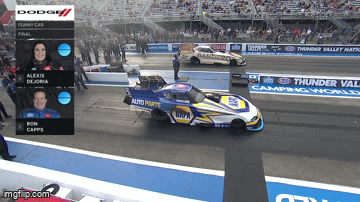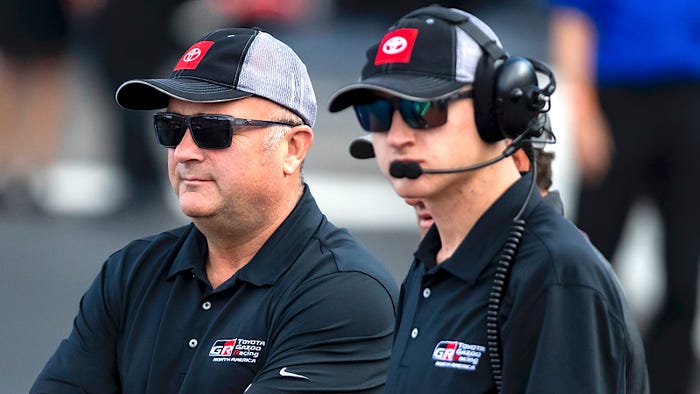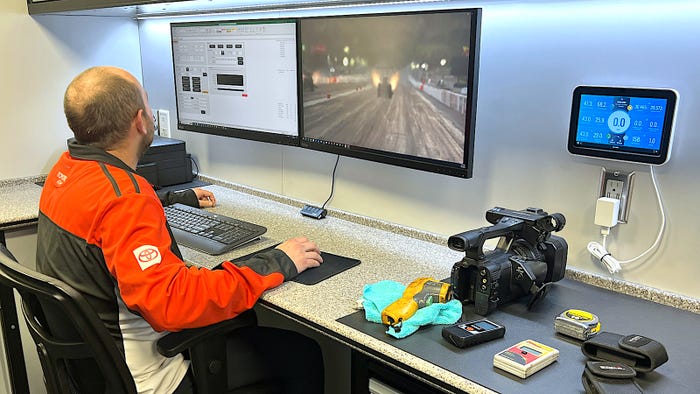Inside Toyota’s NHRA Trackside Engineering Effort
Want to join the engineering crew Toyota Racing Development sends to racetracks with the teams?

Ron Capps wins in his Toyota GR Supra at Bristol, Tenn.NHRA
“In drag racing, you’ve got four seconds to prove your worth.” That’s the observation of Slugger Labbe, engineering manager of vehicle support at Toyota Racing Development. It applies not only to the racing drivers, but also to the crew chiefs who seek to provide drivers with winning equipment, and by extension, to the engineers at the carmakers who aim to help those crew chiefs do their jobs.
“There is nothing easy in drag racing,” Labbe emphasized. “You’ve got one chance on Sunday,” to win the race.
Toyota is unique among manufacturers participating in the National Hot Rod Association’s Funny Car category, in that the company provides trackside engineering support to teams’ crew chiefs to boost their chances of scoring wins. It has paid off, with Toyota winning the NHRA Funny Car championship with the Supra in 2022. The company's program also includes Top Fuel dragsters.

Toyota's Slugger Labbe (left) and Paul Flynn (right) at the drag strip. TOYOTA
Funny Cars are front-engine drag racers that wear carbon fiber bodywork designed to resemble that of a company’s production cars. They shoot 1,000 feet down the track in less than four seconds, crossing the finish line at 330 mph to deploy their drag parachutes to aid in deceleration.
Winning margins are narrow, so every detail matters if a driver and team hope to win. That’s where Toyota track support engineers like Paul Flynn come in. On arrival at a track for a weekend of racing, Flynn says he will provide Toyota’s eight teams (for 2024) with an analysis of the track and a forecast for how the track’s grip can be expected to change over the course of the weekend in response to changing weather and ongoing use.
“One of the things we do is track measurement,” Flynn explained. “It is highly crucial to understand the track’s racing surface. When rubber heats up it will tend to get soft. One of the main factors is the glue we spray onto the track.”
Teams need to know the grip available to decide how to adjust the car’s aerodynamics and its clutch, as the driver needs to be able to send the optimum amount of power to the rear wheels so that they don’t break traction and start spinning.
“[Teams] take these friction readings and use our tools to determine how much power they can put to the tires and find the setup that will be a good run,” Flynn said. “There is a very fine window.”
Toyota provides teams with tools to understand how changing weather is likely to affect their car’s performance. “The swing of a little humidity percentage or temperature makes a big difference,” Flynn continued. Toyota’s software tool “will output what has changed for their tune-up or air pressure in tires or how to set up their clutch.”

A Toyota Racing Development Engineer studies the GR Supra's performance. TOYOTA
Toyota’s toolkit includes software for tuning the car’s engine, its supercharger, the clutch, and its tires. The company also provides teams with a post-race analysis for crew chiefs to consider as they prepare for the next race. “A lot of chiefs and drivers struggle to sleep at night so we give them a lot of material to go over if they’re awake,” Labbe joked.
While Flynn goes to tracks with the teams, Labbe works away from the track to help deliver teams the best hardware possible. When Toyota switched from a Camry body to the Supra body for Funny Car racing, the company had to understand this new body’s aerodynamic properties.
“The goal was to make a Funny Car that looks like what you see on the showroom floor,” Labbe said. “We feel we did a good job and it looks like what you see at dealers.” Toyota also sought to make important improvements to the car for the benefit of drivers. That means having a larger windshield and side windows and adding a roof hatch for faster and easier driver egress (Search “engine explosion” on YouTube if you want to see why drivers might be in a hurry go get out of their car).
Toyota engineers spent two years working on the Supra’s body design in CAD before submitting a design to NHRA. Michigan’s Roush Industries builds those bodies for teams. Toyota’s mission is to understand how the Supra bodywork responds to various adjustments so that teams will know how to achieve their goals during race weekends as they tune the car to suit the specific track and conditions.
That meant more than 600 virtual wind tunnel runs using CFD, and 120 hours in the Windsheer wind tunnel in Concord, N.C. to get the body design finalized, Labbe reported. Since then, the company has run about 60 more hours in the wind tunnel continuing to refine its understanding of the car.
The result of that work is that they “learned how to make it go fast,” said Labbe. “Once the body’s built there’s not much you can tune. So we tested wickers and spoilers so teams would know what they’d have when they make a change.”
Then Toyota’s engineers created a calculator for the teams so they can know what to do when conditions change. “We can shift as much as 3,000 lbs. of downforce,” Labbe noted. That’s important, because “you’ve got to put the downforce in the right places to make it work,” he said.
The resulting reduction in elapsed time for the car may be small, but it could be enough to win races, he said. “We’re looking for thousands of a second.” If that hunt sounds interesting to you, Toyota points out that they are hiring.
About the Author(s)
You May Also Like


.jpg?width=300&auto=webp&quality=80&disable=upscale)


